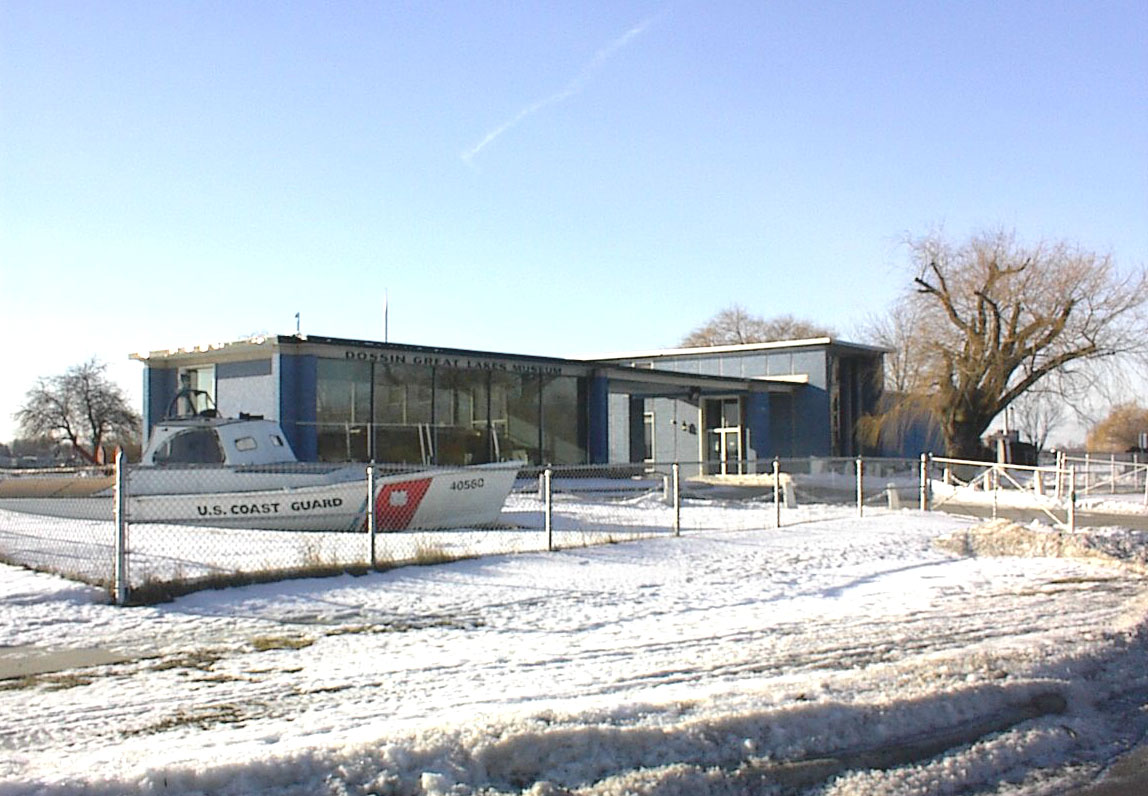
Dossin Great Lakes Museum
100 The Strand on Belle Isle
Facing the Detroit River
Detroit resident Walter Dossin had a passion for racing boats. Detroit, from the late Nineteenth Century through the middle of the last century, was a center for boat racing, with important annual events held every summer on the Detroit River near Belle Isle. Guy Lombardo, a popular band leader from London, Ontario, sponsored boats that accomplished much in the championship series. Dossin decided to challenge the boats of Guy Lombardo and commissioned well-known naval architect, Gus Hacker, to design a vessel that would win championships. His creation, Miss Pepsi, was the leading racing boat in 1947. It was the first, or among the first, boats to exceed 100 miles per hour.
The J. T. Wing was the last commercially active wooden scooner to sail in the Great Lakes. It reached retirement age in 1949 and a group of Detroit residents decided that it should be docked at Belle Isle and serve as something of a museum of Great Lakes ships. This was called the City Maritime Museum and was the forerunner of what is now the Dossin Great Lakes Museum. Apparently, that wooden vessel deteriorated rapidly and there was no money to repair her. For safety reasons, the use of the J. T. Wing as the City Maritime Museum came to an end in 1956.
Walter Dossin and his family were interested in the history of sailing on the Great Lakes. In the mid-1950s, he donated $125,000 to the city for a Marine Museum. The city and Detroit’s Historical Commission matched the Dossin family contribution, so one-quarter million was available to construct the building you see. That amount is equivalent more than two million 2013 dollars. Ground was broken on May 21, 1959 and the structure you see pictured above opened on July 24, 1960. It is located at that point on Belle Isle where the J. T. Wing was moored from 1949 to 1956.
The Great Lakes Maritime Institute is a Detroit non-profit organization that supports and promotes the Dossin Museum. The Museum is now administered by the Detroit Historical Society whose main facility is in the Cultural Center on Woodward.
The Dossin Museum displays a number of interesting items, including the pilot house from the freighter, William Clay Ford. You can enter this pilot house and pretend to captain a huge ore carrier. The William Clay Ford was launched in 1953 and served as a balk carrier in the Ford fleet. The ship was scrapped in 1987 but the pilot house is preserved at the Dossin Museum. There is a gallery of model ships showing vessels that have sailed the Great Lakes since 1679. There is also, on display, the Gothic Room from the City of Detroit III. For the first half of the Twentieth Century, the Detroit and Cleveland Navigation (the D & C Line) provided boat service from Detroit to Cleveland and to Buffalo on Lake Erie from early April until December. Over time, they increasingly built elegant ships to attract businessmen and travelers who visited Detroit. In 1911, the D & C line commissioned Detroit architect, Frank Kirby, to design a very elegant vessel, one built at the large shipyard in Wyandotte. Indeed, they spent 1.5 million dollars for this one ship. That is the equivalent of about 36 million 2010 dollars. Kirby designed the largest sidewheeler that every plied the Great Lakes. That design, presumably, produce very stable travel in troubled seas. Being the shallowest of the Great Lakes, Lake Erie was most tuburlent in storms. To attract businessmen, Kirby included a smoking room, called the Gothic Room. This was paneled in English oak and made extensive use of stained glass. Slow moving, if sumptuous boats, could not compete with cars, modern trains and planes. By 1956 or so, the D and C Line was out of business, but a fascinating component of their pre-World War I business strategy is on display at the Dossin. This museum also is home to one of the large guns used in the War of 1812 on Lake Erie. In September of that year, United States naval forces defeated the British navy in the Battle of Put-in-Bay and, shortly thereafter, General William Henry Harrison took control of Detroit and 13 months of British occupation. This museum supports a web camera that continuously is focused upon the Detroit River so you can watch passing naval traffic. There is a link to this web camera on the website noted below
The architect, William E. Kapp, was trained in architecture at the University of Pennsyulvania and spent many years working in Detroit, for some period with the Smith, Hinchman and Grylls firm. He may also have worked for the Harley, Ellington and Day architectural firm in Detroit He designed - or helped to design - the Detroit Historical Museum and the University of Michigan's Horace Rackham Education Building in the Cultural Center, the Wilson Theater, the University Club and the Players Club - both nearby on East Jefferson and the Art Deco Temple Isreal on Manderson near Palmer Woods.
The Dossin Museum was closed in November, 2012 for a two million dollar remodling and reopened in May 2013. This is another example of the gradual renovation of Belle Isle.
Architects: William E. Kapp
Date of Construction: Groundbreaking: May 21, 19
Website for the Detroit Historical Society: http://www.detroithistorical.org/main/dossin/index.aspx
Website for Great Lakes Maritime Institute: http://www.glmi.org/
City of Detroit Local Historic District: Not Listed
State of Michigan Registry of Historic Sites: Belle Isle; Listed September 10, 1974
National Registry of Historic Sites: #74000999; Listed February 25, 1974
Use in 2014: Museum
Photo: Ren Farley,
Description updated: February, 2014
Return to Entertainment & Culture